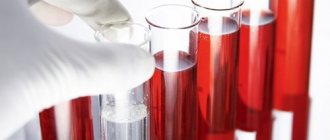Thrombocytopenia
– a pathological condition characterized by a decrease in the number of platelets per unit volume of blood and the resulting increased bleeding. Platelets play an important role in stopping bleeding. The molecules of the outer membrane of this flat blood element are able to recognize damaged areas of blood vessels and integrate into the structure of the capillaries, turning into a kind of “patch”. A decrease in the concentration of platelets in the bloodstream leads to a large number of pinpoint hemorrhages.
Classification of the disease
Thrombocytopenia has its own classification, based on a number of factors, symptoms and manifestations. The mechanism of the initiation and development of thrombocytopenia may be associated with the characteristics of the life cycle of blood platelets:
- decreased platelet formation in the red bone marrow.
- increased destruction of platelets.
- redistribution of platelets in the hematopoietic system due to inflammatory processes in the human body.
According to the etiology, primary and secondary thrombocytopenia are distinguished. First type
manifests itself as an independent disease.
The second type
is as a consequence of pathological abnormalities. Thrombocytopenia can have an acute and chronic course. The acute condition lasts a short time (up to 6 months) and is characterized by a vivid clinical picture. A chronic condition may occur with a gradual increase in symptoms. The severity of the disease depends on the number of platelets in the blood and is conventionally divided into three degrees - mild, moderate and severe. Each of them has its own manifestations - from frequent nosebleeds to hemorrhagic rash (purpura) and extensive bleeding into internal organs.
Treatment of thrombocytopenia
Thrombocytopenia is treated by a hematologist. The treatment regimen is developed individually for each patient: the patient’s age, the presence of any diseases, the degree of deficiency, and the amount of bleeding are taken into account. It is necessary to determine the cause of thrombocytopenia so that treatment is as effective as possible. Standard drug therapy consists of:
- Corticosteroids – have anti-inflammatory and analgesic effects;
- Immunoglobulins – correct the functioning of the immune system;
- Immunosuppressants – stop the destructive effect of the immune system on the body;
- Agonists to thrombopoietin receptors – promote more active production of this hormone.
In case of thrombocytopenia caused by bleeding, it is necessary to identify the source of this bleeding and stop it. Only after this the platelet correction is carried out. The patient will have to take medicinal iron and drugs that promote the production of red blood cells.
If drug treatment does not produce any results, splenectomy is indicated - surgical excision of the spleen. For hereditary diseases that prevent the body from producing enough platelets, a bone marrow transplant is necessary. If the platelet level is critically low, a blood transfusion of platelet mass from a donor is performed. If a large volume of blood is lost, a transfusion of fresh frozen plasma and red blood cells is necessary.
Causes of thrombocytopenia
Among the various reasons causing this serious disease, the main ones are:
Causes
Often the cause of the disease is an allergic reaction of the body to various medications, resulting in drug-induced thrombocytopenia . With such ailment, the body produces antibodies directed against the drug. Medicines that affect the occurrence of blood cell insufficiency include sedatives, alkaloids and antibacterial agents. The causes of deficiency may also be problems with the immune system caused by the consequences of blood transfusions. The disease manifests itself especially often when blood groups do not match. Autoimmune thrombocytopenia is most often observed in the human body . In this case, the immune system is unable to recognize its platelets and rejects them from the body. As a result of rejection, antibodies are produced to remove foreign cells. If the disease has a pronounced form of an isolated disease, then it is called idiopathic thrombocytopenia or Werlhof's disease . It is believed that such thrombocytopenia occurs due to a hereditary predisposition. The manifestation of the disease is also typical in the presence of congenital immunodeficiency. A lack of platelets in the body is observed in people with a reduced composition of vitamin B12 and folic acid. Excessive radioactive or radiation exposure to cause blood cell deficiency cannot be ruled out.
Symptoms of thrombocytopenia
The clinical picture of thrombocytopenia depends on the cause of this pathology, as well as the severity of the disease. The main signs are multiple hemorrhages on the skin, as well as spontaneous bleeding - nasal, pulmonary, uterine. Other manifestations of the disease:
Causes of the disease
Causes of thrombocytopenia include:
- Hereditary diseases. Bernard-Sourya syndrome, TAR syndrome, May-Hegglin anomalies and other diseases that can provoke pathological bleeding.
- Diseases that interfere with the creation of new platelets. Most often, this is due to bone marrow problems, cancer, reactions to chemical and radioactive elements, and leukemia. And sometimes even against the background of alcohol and drug abuse.
- Diagnoses that provoke excessive consumption of platelets by the body. A striking example of such a disease is DIC syndrome. There is an increase in platelet consumption, and as a result, the bone marrow increases its work on the formation of new cells. Over time, he gets tired, his reserves are depleted and thus new platelets do not appear in the blood.
- Increased size of the spleen. The fact is that a large number of platelets are stored in the spleen, as if in a depot. But when its size is pathologically large, it takes on too many cells, which leads to a decrease in them in the blood, and the bone marrow, in turn, does not compensate for the deficiency.
- Autoimmune thrombocytopenia. It develops when the body begins to destroy platelets in the blood.
- Drug-induced thrombocytopenia. Some groups of drugs can destroy platelets or suppress their formation in the bone marrow. For example, long-term use of cytostatics.
Many drugs can cause thrombocytopenia, but it is still quite rare. According to research, about 10 cases per 1 million population per year. (https://pubmed.ncbi.nlm.nih.gov/15588119/)
Cost of consultation for thrombocytopenia?
| Name of service | Price, rub.) |
| Initial appointment with a cardiologist | 2000 rub. |
| Repeated appointment with a cardiologist | 1500 rub. |
| Primary appointment with a general practitioner | 2000 rub. |
| Repeated appointment with a general practitioner | 1500 rub. |
| Prescription of treatment (drawing up an individual treatment regimen) | 1500 - 3000 rub. |
All our services and prices
Prognosis and prevention
Thrombocytopenia is a dangerous disease that poses a huge threat to the life and health of the patient. Anemia often develops, and vision loss can occur due to hemorrhages in the retina. Advanced forms can provoke hemorrhages in the internal organs and in the brain. In most cases this leads to death.
Thrombocytopenia has no specific prevention. Experts give the following recommendations:
- Take a general blood test every year and undergo a general medical examination;
- Eat properly and nutritiously: eat as much meat and fresh vegetables as possible;
- Play sports and lead an active lifestyle;
- Avoid self-medication: taking aspirin and steroid drugs should be under the strict supervision of a doctor;
- Try to avoid any procedures where there is a risk of cutting (shaving, manicure);
- Treat any infectious processes in a timely manner;
- Take precautions when working with chemicals;
- Give up bad habits: drinking alcohol slows down platelet production.
Thrombocytopenia is a disease that requires constant medical supervision. If you suspect you have it or know about the pathology and want to get rid of it, contact the Medscan medical center. Experienced doctors will perform the necessary diagnostics and develop an individual treatment plan.
Diagnosis and treatment
Increased bleeding
– a reason to immediately seek advice from a specialist (hematologist), who will take a detailed medical history and prescribe the necessary examinations. The main diagnostic method is a clinical blood test, which determines the quantitative composition of platelets. The patient may also be recommended a bone marrow puncture to assess the quality of this type of hematopoiesis, ultrasound of the spleen, chest x-ray, and tests for the presence of antibodies. During pregnancy, thrombocytopenia is diagnosed using a coagulogram (blood clotting test), which allows one to determine the quantitative composition of platelets in a woman’s blood.
A serious disease such as thrombocytopenia should be treated only under the supervision of a doctor. After receiving the results of all examinations, the specialist selects individual therapeutic measures for each patient. Severe hemorrhagic syndrome requires urgent hospitalization and emergency care. For severe bleeding, platelet transfusions are indicated, and angioprotectors and fibrinolysis inhibitors are prescribed. Avoid taking acetylsalicylic acid and anticoagulants. If there is a deficiency of vitamin B12 or folic acid, medications with a high content of these elements are prescribed. This significantly improves the general condition of the patient and the results of his tests. If immune thrombocytopenia is diagnosed, a course of prednisolone will be required. The dosage is determined by the individual characteristics of the patient and his body. If drug therapy is ineffective and repeated bleeding occurs, splenectomy (removal of the spleen) is indicated. For non-immune thrombocytopenia, symptomatic hemostatic therapy is recommended.
There is no special diet for thrombocytopenia, but you should adhere to the principles of a rational, balanced diet. You should introduce more vegetables, fruits, herbs, low-fat dairy products, vegetable oils, legumes, and seafood into your diet. Alcohol consumption is strictly prohibited. Undesirable foods: white rice, sugar, baked goods, marinades and pickles.
After consulting with your doctor, you can use traditional medicine - infusions and decoctions of medicinal herbs, sesame oil.
Methods for diagnosing thrombocytopenia
At the initial stages, it is possible to diagnose thrombocytopenia only based on the results of a general blood test - based on a reduced level of platelets. But to identify possible causes of the pathology and its complications, the patient will have to undergo an extensive examination. Standardly it includes:
- Biochemical blood test – reflects the general condition of the body;
- Genetic blood test - identifies hereditary diseases that can cause thrombocytopenia;
- Duke bleeding time assessment – determines the state of the circulatory system;
- Determination of blood clotting rate;
- Bone marrow puncture - evaluates the composition and structure of red cells;
- Immunological blood test - detects antibodies to platelets IgG;
- Ultrasound of the liver and spleen determines the size of these organs.
Normal platelet count in blood
The number of platelets in the body should normally vary from 180 to 320*10^9 for women and from 200 to 400*10^9 for men per liter of blood. Moreover, the number of platelets in women can change during menstruation to 75 * 10^9 per liter of blood, can decrease in the third trimester in pregnant women and, regardless of gender, increase in response to an inflammatory reaction, which seems to be a physiological norm and is not a deviation, without carrying negative symptoms.
In children, the normal platelet count depends directly on the age of the child. For a newborn, the norm will be 100-420*10^9 per liter of blood, and at two weeks of age and up to a year it is 150-350*10^9 per liter of blood. Up to five years, the amount changes slightly to 180-350*10^9 per liter of blood. By the age of seven, the norm reaches 180-450*10^9 per liter of blood.
For prevention, you need to take a blood test at least once a year in order to identify a possible pathology as early as possible and begin its treatment as soon as possible at an early stage, before the development of a severe clinical condition. If a deviation is detected, a blood test is performed more often.
They live in the body for only 9-10 days, after which they are renewed, destroyed in the liver or spleen and re-proliferate in the bone marrow.
Transcription of analyzes online.
cost of service: 500,300 rubles
Order
General practitioner Khanova Irina Ivanovna will interpret your tests during an online call in the Zoom or WhatsApp application.
- detailed explanation from the general practitioner.
- an alternative opinion from a competent specialist in interpreting the analyses.
- the opportunity to ask questions to the doctor regarding test results.
Nutrition
In mild forms of thrombocytopenia, following a diet can have a good effect. Products that thin the blood must be excluded from the diet. First of all, it is ginger, tomato juice, some fruits and berries (citrus fruits, raspberries, cranberries).
When preparing your daily diet, you must adhere to the following rules:
- eat foods that increase platelet levels: nuts, eggs, cereals (buckwheat, rice), liver, sea fish;
- eat enough permitted fruits and vegetables;
- refuse canned and pickled foods;
- exclude spicy, too hot and cold dishes.
Diet is important for any thrombocytopenia. Following your doctor's recommendations, proper nutrition and a healthy lifestyle will prevent the development of the disease and increase the likelihood of recovery.
Diagnostics
Any disease that is accompanied by increased bleeding requires the intervention of a hematologist. The first test that is performed on all patients with suspected thrombocytopenia is a complete blood count with platelet count. Next, a peripheral blood smear is performed, which allows us to determine the possible cause of thrombocytopenia.
To exclude coagulopathy (blood clotting disorders), a hemostasiogram (a set of indicators of the blood coagulation system) is examined. Ultrasound examination (US) of the spleen and chest radiography are used as additional diagnostic methods.
Platelet diagnostics
At the first appearance of relevant clinical symptoms (bleeding and bruising), it is necessary to consult a specialist, in this case it is a general practitioner. There is no need to postpone going to the doctor until the clinic gets worse, because in this case the treatment will be more difficult and the outcome will be less favorable.
To diagnose thrombocytopenia, you must first take a blood test. If the analysis reveals a low platelet count, the general practitioner may refer you to a hematologist, who will prescribe additional tests, such as:
- Coagulogram with determination of clotting time.
- Blood biochemistry for LDH, ASAT, ALAT and bilirubin.
- Antibody test.
- MRI.
- Ultrasound of the abdominal organs.
- Genetic studies (to exclude hereditary thrombocytopenia).
After conducting research and identifying the true cause of thrombocytopenia, a general practitioner or hematologist prescribes appropriate treatment, which includes eliminating the cause of the decrease in platelet count.
Transcription of analyzes online.
cost of service: 500,300 rubles
Order
General practitioner Khanova Irina Ivanovna will interpret your tests during an online call in the Zoom or WhatsApp application.
- detailed explanation from the general practitioner.
- an alternative opinion from a competent specialist in interpreting the analyses.
- the opportunity to ask questions to the doctor regarding test results.
Types of thrombocytopenia
Depending on the causes of development, thrombocytopenia is divided into several types.
Hereditary
A group of diseases caused by a genetic mutation:
- May–Hegglin anomaly;
- congenital amegakaryocytic thrombocytopenia;
- Wiskott–Aldrich syndrome;
- TAR – syndrome;
- Bernard–Soulier syndrome.
Productive
A group of diseases of the hematopoietic organs with a characteristic change in the process of platelet production by red bone marrow:
- acute leukemia;
- aplastic anemia;
- myelofibrosis;
- myelodysplastic syndrome;
- megaloblastic anemia.
Also, a productive form of the disease can develop as a result of metastasis of a cancerous tumor (the diagnosis is made and treated by an oncologist), the use of cytostatic drugs, hypersensitivity to medications, exposure to radiation, and alcohol abuse.
Destruction
Leads to increased destruction of platelets in the spleen, sometimes in the liver or lymph nodes:
- idiopathic thrombocytopenic purpura;
- post-transfusion thrombocytopenia;
- thrombocytopenia of newborns;
- Evans–Fisher syndrome;
- drug and viral thrombocytopenia.
Consumption
Platelets are activated in the vascular bed, which triggers the blood coagulation mechanism, which has a pronounced symptomatic character. The greater the consumption of platelets, the more the body tends to produce them.
If the cause of activation is not eliminated, the compensatory capabilities of the red brain will be exhausted:
- hemolytic-uremic syndrome;
- thrombotic thrombocytopenic purpura;
- disseminated intravascular coagulation syndrome;
Breedings
It develops as a consequence of massive bleeding, during which the patient was transfused with a large volume of fluid, plasma substitute, plasma or red blood cells. However, the moment of need to compensate for platelet loss was missed.
Their concentration in the blood decreases so much that the emergency release of platelets from the depot does not help maintain adequate functioning of the coagulation system.
Redistributions
A consequence of impaired platelet deposition due to splenomegaly. 90% of platelets settle in the spleen, which literally “confuses the body.” Regulatory systems take into account their total amount, and not the amount that circulates in the blood.
Doctor's advice
Many people wonder whether thrombocytopenia is curable. It depends on the reason. If it is an infection, then when it is cured, all symptoms go away. In case of liver pathologies, complete relief from thrombocytopenia is also possible. If it’s leukemia, then when the condition stabilizes, the platelet count increases, but there will be concern about a relapse. In the case of congenital genetic abnormalities, the disease cannot go away because the body does not work correctly. But there is always supportive therapy that allows you to maintain a decent standard of living.
Victoria Druzhikina Neurologist, Therapist
A large percentage of deposition by the spleen leads to a compensatory increase in their production, this happens when:
- liver cirrhosis (hepatologist treats and consults);
- systemic lupus erythematosus;
- alcoholism;
- lymphoma or leukemia;
- infectious invasion: malaria, hepatitis, tuberculosis, etc.
In children
In a child, the pathology is expressed in a typical symptomatic complex, complicated by hemorrhagic syndrome. It develops against the background of a decrease in the number of platelets, due to their rapid destruction or insufficient production.
An increased rate of platelet destruction is a consequence of:
- immunopathological processes leading to heteroimmune, transimmune and isoimmune thrombocytopenia;
- vasopathy, Kasabach-Merritt syndrome, systemic inflammatory response syndrome, respiratory system disorder syndrome, aspiration syndrome, pneumonia, pulmonary hypertension, infectious invasions, disseminated intravascular coagulation syndrome;
- thrombocytopathies of Wiskott-Aldrich, Shwachman-Diamond, May-Hegglin,
- overdose of certain drugs, hyperbilirubinemia, acidosis, generalized form of viral infections, long-term parenteral nutrition;
- isolated or generalized post-traumatic thrombosis, hereditary deficiency of antithrombin III and protein C, antiphospholipid syndrome in the mother;
- blood transfusion, hemosorption, plasmapheresis.
A common cause of decreased platelet production in children is megakaryocytic hypoplasia caused by TAR syndrome, leukemia, aplastic anemia, neuroblastoma, and trisomy.
Newborns are at risk when the rate of thrombocytopoiesis in the mother decreases, preeclamptic conditions during pregnancy, extremely low birth weight, antenatal hemolytic disease, deficiency of thrombocytopoietin production, etc.
Children's thrombocytopenia can develop against the background of severe suffocation, infection, sepsis, polycythemia, and thyrotoxicosis. A pediatrician treats diseases in children.
For infants, the pathology is dangerous due to an asymptomatic increase in the rate of platelet destruction.
Only 5-7% of total cases of childhood thrombocytopenia are associated with a quantitative decrease in platelet synthesis.
Treatment and severity
Treatment of thrombocytopenia most often comes down to identifying the primary disease and its treatment, as well as eliminating various unpleasant symptoms. In the process, it is also important to take into account that the severity of thrombocytopenia varies:
Mild degree. It assumes that the platelet concentration is from 50 to 150 thousand units per microliter. The condition of the capillaries is usually normal, bleeding does not develop. Usually, treatment is not necessary at this stage - doctors recommend waiting and monitoring the development of the patient’s condition.
Average degree. In this case, the concentration is 20-50 thousand platelet units per microliter. Under this condition, bleeding gums and nosebleeds are observed. If injuries and bruises occur, serious hemorrhages form in the skin. At this stage, drug therapy may be prescribed.
Severe degree. The platelet concentration is below 20 thousand, hemorrhages are spontaneous and severe. At the same time, the patient himself may feel quite comfortable, does not complain of feeling unwell, but tests show that he needs help.
Since the treatment of thrombocytopenia requires the most thorough and detailed diagnosis, it is important to choose a modern clinic that will help you. JSC "Medicine" in Moscow is just the place where you can get qualified help from the best specialists. The clinic has everything necessary for both examination and treatment of each patient.






